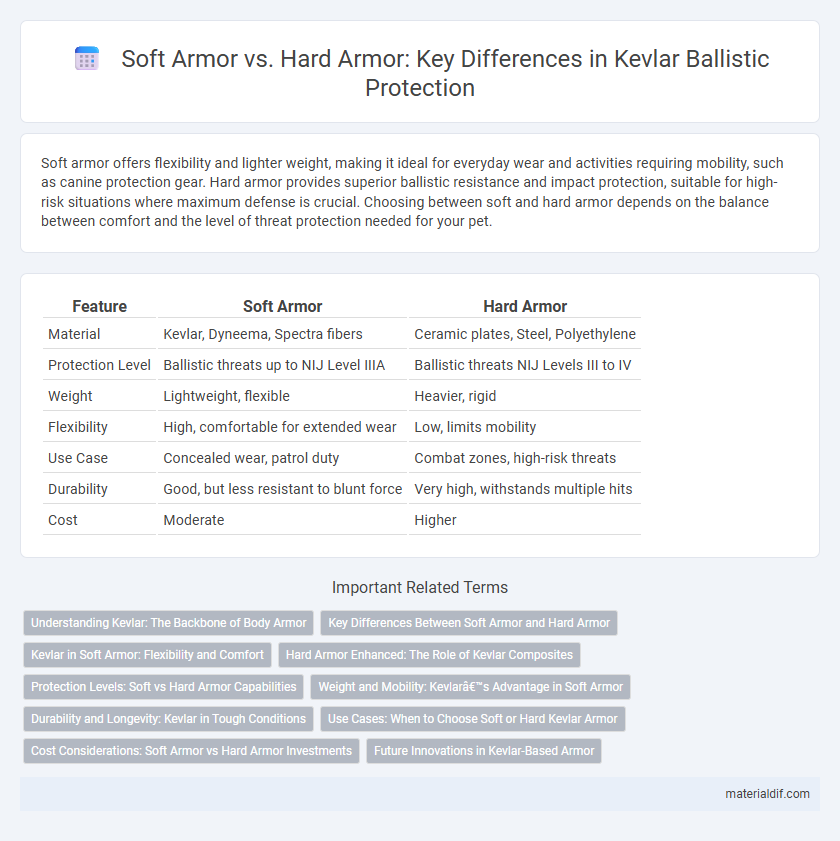Soft armor offers flexibility and lighter weight, making it ideal for everyday wear and activities requiring mobility, such as canine protection gear. Hard armor provides superior ballistic resistance and impact protection, suitable for high-risk situations where maximum defense is crucial. Choosing between soft and hard armor depends on the balance between comfort and the level of threat protection needed for your pet.
Table of Comparison
| Feature | Soft Armor | Hard Armor |
|---|---|---|
| Material | Kevlar, Dyneema, Spectra fibers | Ceramic plates, Steel, Polyethylene |
| Protection Level | Ballistic threats up to NIJ Level IIIA | Ballistic threats NIJ Levels III to IV |
| Weight | Lightweight, flexible | Heavier, rigid |
| Flexibility | High, comfortable for extended wear | Low, limits mobility |
| Use Case | Concealed wear, patrol duty | Combat zones, high-risk threats |
| Durability | Good, but less resistant to blunt force | Very high, withstands multiple hits |
| Cost | Moderate | Higher |
Understanding Kevlar: The Backbone of Body Armor
Kevlar's unique aramid fiber structure provides exceptional tensile strength, making it the cornerstone of soft body armor that offers flexibility and lightweight protection against ballistic threats. In contrast, hard armor incorporates rigid materials such as ceramic or metal plates alongside Kevlar to stop higher-velocity projectiles and rifle rounds. Understanding Kevlar's durability and layering capabilities highlights its critical role in balancing protection, mobility, and comfort across different body armor systems.
Key Differences Between Soft Armor and Hard Armor
Soft armor, composed primarily of Kevlar fibers, offers lightweight, flexible protection against handgun rounds and shrapnel, making it ideal for everyday wear by law enforcement and security personnel. Hard armor incorporates rigid plates made from materials such as ceramic, polyethylene, or steel, providing superior defense against rifle rounds and high-velocity projectiles but is heavier and less flexible. The key differences lie in protection level, weight, and flexibility, with soft armor excelling in comfort and mobility while hard armor delivers enhanced ballistic resistance.
Kevlar in Soft Armor: Flexibility and Comfort
Kevlar in soft armor offers exceptional flexibility and comfort, making it ideal for daily wear by law enforcement and security personnel. Its lightweight and woven fiber structure allow for efficient impact absorption while maintaining freedom of movement. Unlike hard armor, Kevlar soft armor provides discreet protection without compromising agility or prolonged wearability.
Hard Armor Enhanced: The Role of Kevlar Composites
Hard armor enhanced with Kevlar composites delivers superior ballistic protection by combining rigidity with high tensile strength, effectively dispersing impact energy from high-velocity projectiles. This composite structure improves resistance against armor-piercing rounds while maintaining a manageable weight compared to traditional ceramic or metal plates. Kevlar's ability to absorb and dissipate kinetic energy makes it a critical component in advanced hard armor systems designed for military and law enforcement applications.
Protection Levels: Soft vs Hard Armor Capabilities
Soft armor, typically made from Kevlar fibers, excels at stopping handgun rounds and shrapnel, providing flexible, lightweight protection suitable for everyday wear. Hard armor plates, usually composed of ceramic or steel, offer superior defense against rifle rounds and armor-piercing bullets, achieving higher protection levels such as NIJ Level III and IV. The choice between soft and hard armor depends on threat assessment, with hard armor capable of stopping more penetrating projectiles at the cost of increased weight and reduced mobility.
Weight and Mobility: Kevlar’s Advantage in Soft Armor
Kevlar soft armor offers a significant weight reduction compared to traditional hard armor plates, enhancing wearer mobility and comfort. Its lightweight composition allows for extended wear during long missions without compromising agility or endurance. This balance of protection and flexibility makes Kevlar soft armor the preferred choice for law enforcement and military personnel seeking both safety and ease of movement.
Durability and Longevity: Kevlar in Tough Conditions
Kevlar soft armor provides exceptional flexibility while maintaining high durability and resistance to wear in tough conditions, making it ideal for prolonged use in dynamic environments. Hard armor plates, often incorporating ceramic or polyethylene alongside Kevlar layers, offer superior protection against higher caliber threats but can suffer from greater wear and potential impact damage over time. The longevity of Kevlar in both soft and hard armor depends significantly on environmental factors such as moisture, UV exposure, and physical abrasion, with proper maintenance extending its service life considerably.
Use Cases: When to Choose Soft or Hard Kevlar Armor
Soft Kevlar armor is ideal for everyday wear by law enforcement and security personnel due to its flexibility and lightweight design, providing protection against handgun threats. Hard Kevlar armor plates are better suited for military operations or high-risk environments where rifle rounds and higher-caliber ballistic threats are common, offering enhanced durability and impact resistance. Selecting soft or hard Kevlar armor depends on threat level, mobility requirements, and the specific protection needed for the user's operational context.
Cost Considerations: Soft Armor vs Hard Armor Investments
Soft armor generally offers a more cost-effective initial investment compared to hard armor, with prices ranging from $300 to $800 for basic ballistic vests. Hard armor plates, often made from materials like ceramic or polyethylene, typically cost between $200 to $1,200 per plate, requiring multiple plates for full coverage. Long-term maintenance and replacement costs may also influence total expenses, as hard armor plates can be heavier and may degrade differently than soft armor composites like Kevlar.
Future Innovations in Kevlar-Based Armor
Future innovations in Kevlar-based armor emphasize enhancing flexibility and lightweight properties of soft armor while improving the impact resistance and multi-threat protection found in hard armor. Advanced nanotechnology integration and hybrid layering techniques are being developed to increase the tensile strength and energy absorption capacity of Kevlar fibers. These breakthroughs promise to deliver armor that offers superior comfort without compromising ballistic performance for law enforcement and military applications.
Soft armor vs Hard armor Infographic

 materialdif.com
materialdif.com